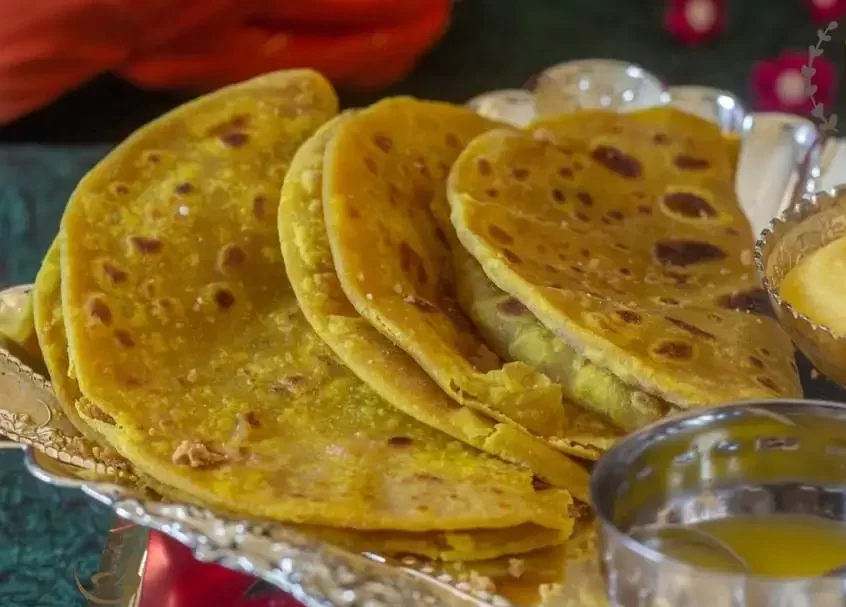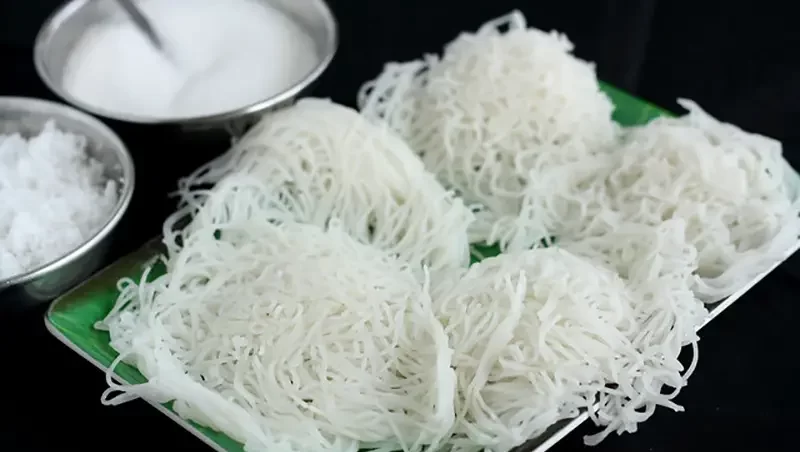Introduction
Puran Poli Recipe:
Puran Poli Recipe: Puran Poli is a beloved Maharashtrian sweet flatbread, often enjoyed during festive occasions like Diwali, Ganesh Chaturthi, and Holi. It consists of a soft, flavorful filling made from lentils, jaggery, and spices, enclosed within a tender, wheat-based dough.
About
Puran Poli Recipe:
Puran Poli, literally translating to “Sweet Stuffed Flatbread” in Marathi, is a cherished delicacy in Maharashtra Cuisine. The filling, known as “Puran,” is made from cooked chana dal (Bengal gram) sweetened with jaggery and flavored with cardamom and nutmeg powder. The dough, typically made from wheat flour or a combination of wheat and all-purpose flour, forms the outer covering.
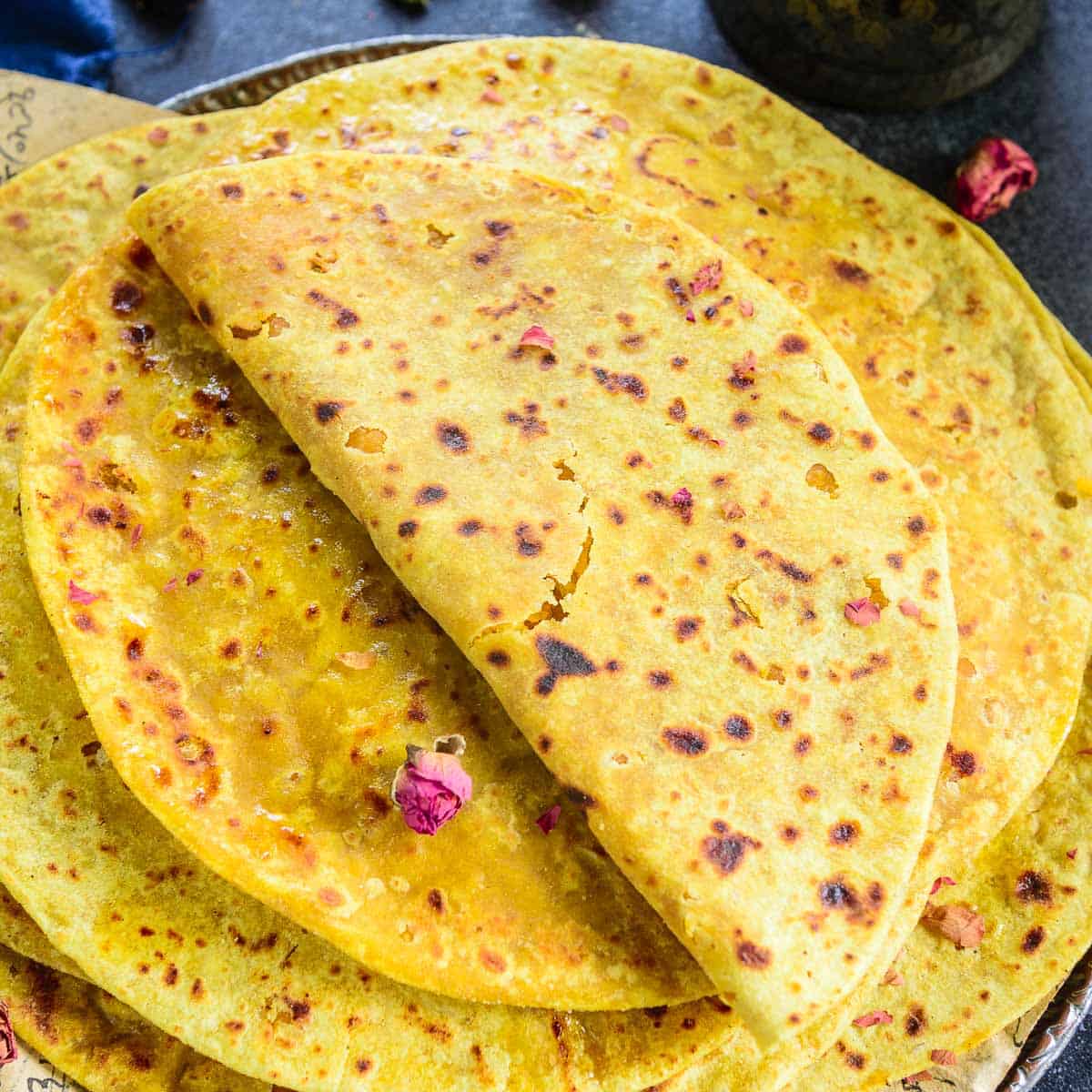
Puran Poli vs Bobbatlu vs
Obbattu:
- In Andhra Pradesh, Bobbatlu are prepared without turmeric. The dough is primarily made with whole wheat flour, although this may vary by region. Some individuals also opt for an all-purpose flour dough, resembling the Karnataka-style holige.
- Karnataka-style Obbattu, also known as holige, typically feature a dough made predominantly with all-purpose flour and a generous amount of oil. These are hand-stretched rather than rolled, resulting in paper-thin sheets filled with various stuffing options.
How to Make Puran Poli Recipe
(Step-by-Step Guide):
Preparation:
- Rinse 1 cup of chana dal thoroughly in a cooker. Add 2 ½ cups of water and half a teaspoon of ghee. Pressure cook until soft, around 5 to 6 whistles. For Instant Pot, set the timer to 10 minutes on the high-pressure cook mode.
- While the dal cooks, prepare the dough for the covering. Combine 2 ½ cups of flour. You can use a combination of 2 cups of wheat flour and ½ cup of all-purpose flour. If you prefer, you can use only wheat flour (details in the tips below).
- Add a pinch of salt and optionally, ¼ teaspoon of turmeric. Gradually add warm water to make a soft dough. I used approximately ¾ cup plus 3 tablespoons of water. Adjust as needed, especially if using only whole wheat flour.
- Drizzle 3 tablespoons of oil into the dough and knead until it absorbs all the oil, becoming soft and pliable. The dough should dent easily when pressed with a finger.
- Cover the dough and let it rest while the puran (filling) is prepared. It requires at least 1 hour of resting time, but longer resting yields better results, especially when using wheat flour. You can also prepare it the night before and refrigerate it for up to 2 days.
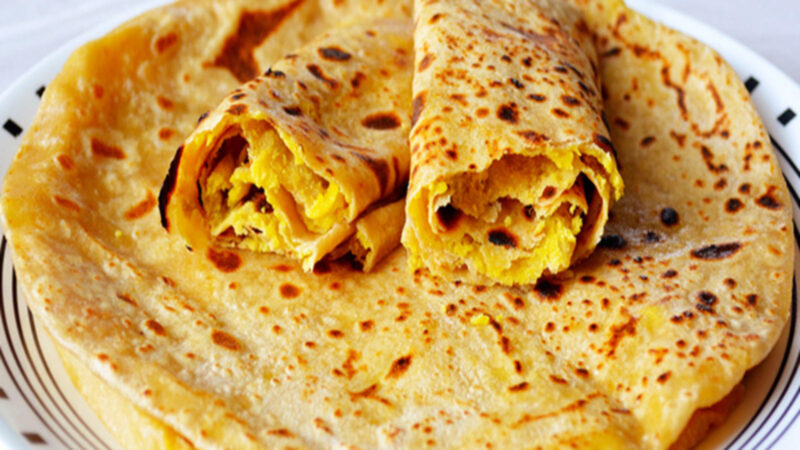
Preparing the Filling –
Puran Poli Recipe
- Once the pressure naturally releases, open the lid. Check if the chana dal is soft and well-cooked by mashing it between your thumb and forefinger. It should easily mash and have very little water left in the pot.
- Transfer the cooked dal to a strainer, allowing it to cool. Then, add the dal to a blender jar and make a smooth paste. Alternatively, you can pass it through a strainer by rubbing the dal against it with a sturdy spoon or steel cup. Collect the smooth dal at the bottom. Note that this may require some effort, so blending is also an option.
- Return the dal to the same pot. If there’s any remaining dal water/stock, you can leave it in the pot.
- Add jaggery to the pot. Stir and cook over medium flame to prevent splattering. The jaggery will melt, and the mixture will become gooey.
- Cook until the mixture slightly thickens. Then, add 1 tablespoon of ghee around the edges of the pan and continue cooking until the entire mixture starts to leave the pan.
- Mix in cardamom powder. Optionally, you can also add nutmeg powder. Stir well and turn off the stove when the mixture reaches a thick consistency, as shown in the picture below. As it cools, it will further thicken. The puran should be smooth at this stage. Allow it to cool completely.
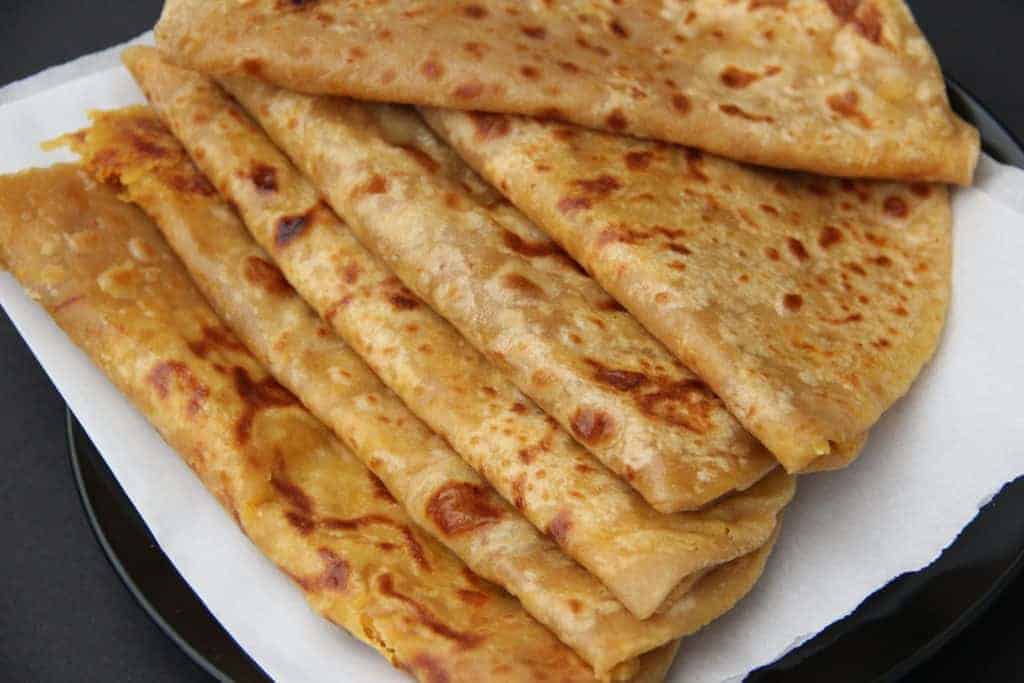
Rolling Puran Poli
- Divide the dough into 12 equal parts and the puran/stuffing into 12 equal parts.
- Take a dough ball and slightly flatten it. Dip it in flour and dust off the excess. I prefer using all-purpose flour here as wheat flour can make them tough or hard.
- With your thumbs and fingers on both hands, shape it into a cup or puri. Make it around 3 ½ to 4 inches in diameter.
- Place a ball of puran in the center and press it down gently.
- Lift the edges of the dough cup and bring them together by tapping the whole thing on your hand and stretching the dough on the sides.
- Continue pushing the puran in and stretching the dough on the sides until you can bring all the edges together on top.
- Seal the edges together, joining them. Do not remove any excess dough; instead, pat it back. Refer to the video for proper technique.
- Gently flatten it between your palms or with your fingers to make a small puri.
- Dust some flour on the rolling board and place the puri on it. Also, sprinkle some flour on top.
- Roll it out as thinly as possible, being careful not to tear the covering. Roll it to about 8 to 9 inches in diameter, ensuring even distribution of the puran and covering, including the sides. If the poli becomes too thin and is about to tear, sprinkle some flour and gently pat it.
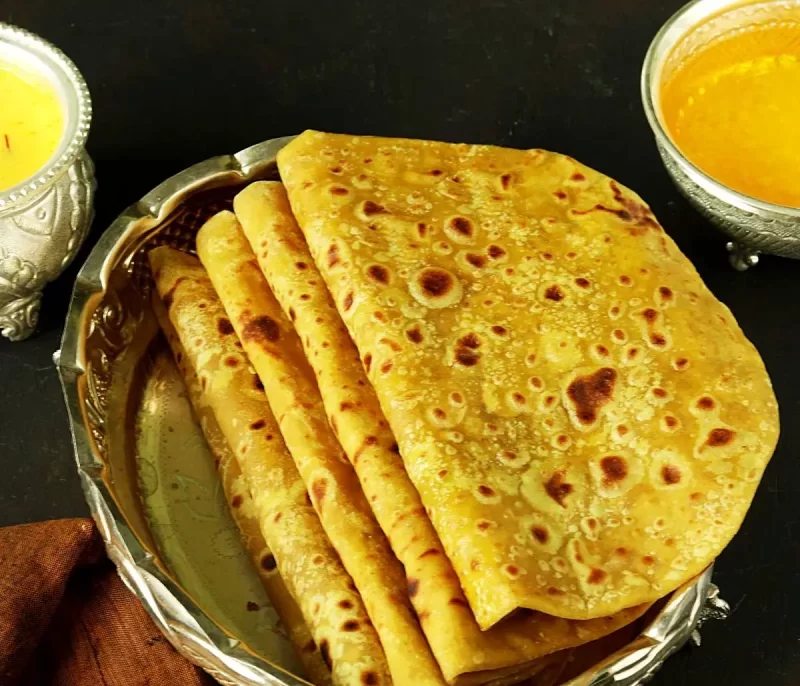
Frying/Toasting
- Heat a griddle over medium-high flame. Prepare 3 to 4 polis at a time for cooking. Once the pan is sufficiently hot, remove any excess flour from the puran poli and transfer it to the hot griddle.
- Bubbles will start to form on the puran poli. Gently flip it to the other side, pressing down with a spatula to ensure it puffs up completely. Drizzle with ghee as desired and cook until evenly done, including the edges. Use approximately one tablespoon of ghee for each puran poli.
- Flip to the other side and spread more ghee as desired. Transfer to a serving plate. Spread enough ghee over the puran polis and stack them.
Serving Suggestion
- Serve with ghee, milk, or katachi amti / holige saaru. These are also delicious dipped in kesar badam milk.
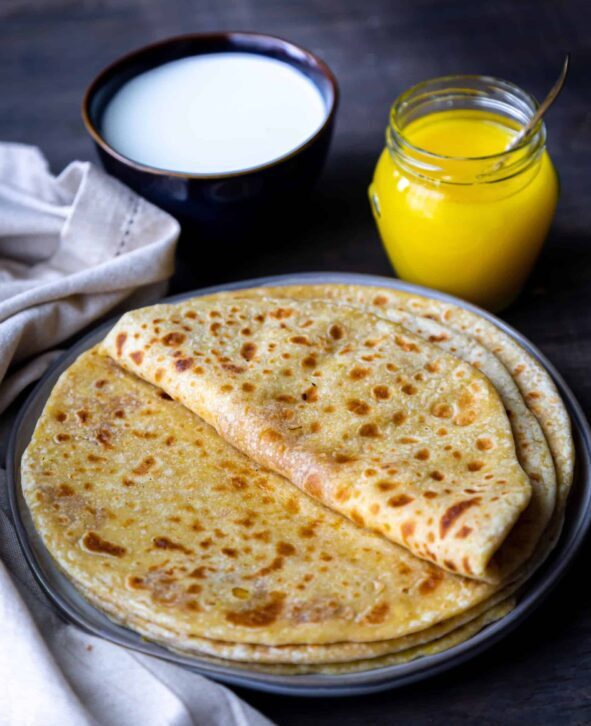
Pro Tips
for Puran Poli Recipe
- Dal: If you plan to make katachi amti or holige saaru, use 4 cups of water to boil the dal and strain it. Use the collected dal stock to make the amti or saaru. If using toor dal, use only 2 cups of water to pressure cook and reduce the cooking time.
- Jaggery: Dark-colored and powdered jaggery will result in darker or brown-colored puran. If you prefer a lighter color, choose lighter jaggery.
Tips
for Making the Covering:
- Choosing flour: Using only wheat flour can result in a nuttier and denser covering if not prepared well. Use 1¼ tablespoons of oil for every cup of atta. Rest the dough overnight in the fridge and bring it to room temperature before rolling.
- For special occasions, use a mixture of 2 cups of atta and ½ cup of all-purpose flour for better results.
- Use organic or unbleached all-purpose flour for health reasons, avoiding regular maida.
- Whole wheat pastry flour or white wheat flour can be used for thinner puran poli.
- Use a good amount of oil in the dough for stretching the poli well.
- Turmeric adds color but not flavor to the puran poli. It can be skipped if desired.
Tips for Using Ghee
- Ghee aids in digesting lentils, so a generous amount is traditionally used in cooking puran poli. Adjust the quantity according to taste and dietary preferences.
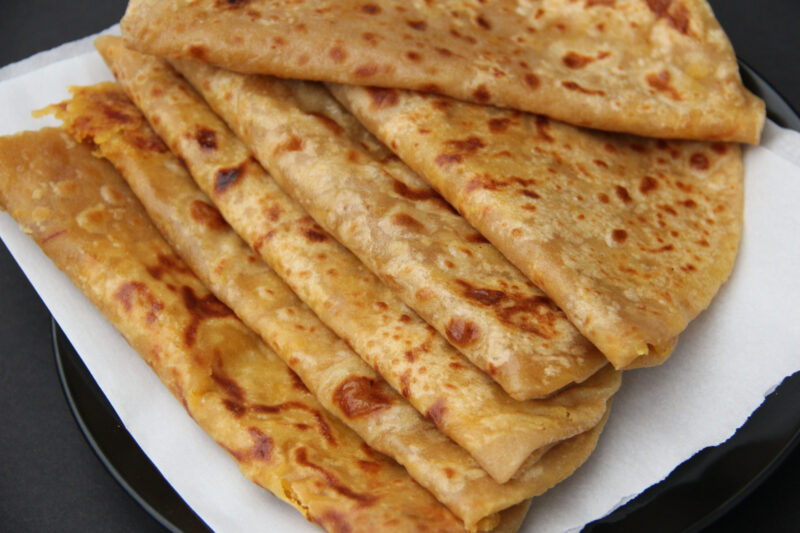
Conclusion
Puran Poli Recipe is a delightful treat enjoyed during festivals and special occasions. With its soft, flavorful filling and tender dough, it captivates the palate with every bite. By following the step-by-step guide and pro tips provided, you can create authentic Puran Poli that will surely impress your family and friends. Enjoy the rich flavors and cultural heritage encapsulated in this beloved Maharashtrian delicacy!
FAQs
about Puran Poli Recipe
Can I use only wheat flour for the dough?
Yes, you can use only wheat flour, but using a combination of wheat and all-purpose flour yields better results.
How long can I refrigerate the dough?
You can refrigerate the dough for up to 2 days for better flavor and texture.
Can I skip turmeric in the dough?
Yes, turmeric is optional and can be skipped if desired.
What is the purpose of adding oil to the dough?
Oil helps in making the dough soft and pliable, resulting in tender puran polis.
How much ghee should I use for frying?
Use approximately one tablespoon of ghee for frying each puran poli, adjusting according to preference.

